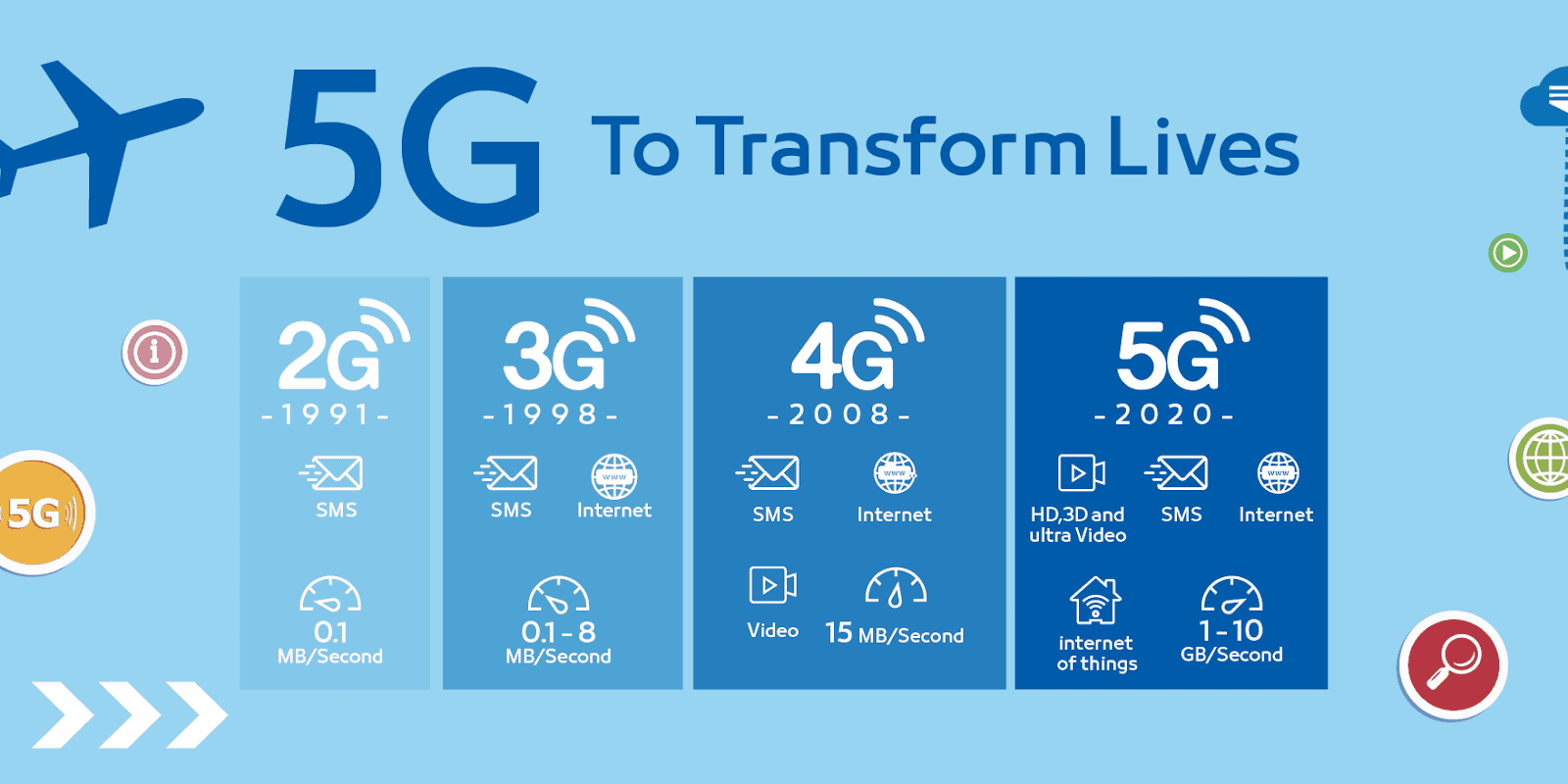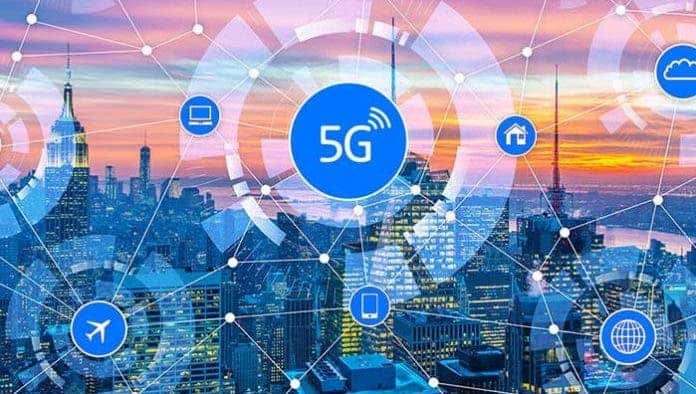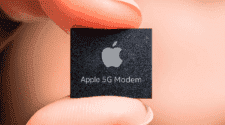Since 2018, 5G has been on everyone’s lips. But we bet only a few people know what 5G is all about. If asking an average user, they will say it’s the faster variant of 4G. And though there is a gain of truth, 5G technology is more than you think. In this article, we will try to introduce to you all the highlights of this technology.
From 1G to 5G
1G: This refers to the first generation of wireless telephone technology, namely mobile communications. It uses analog signals and has a speed of up to 2.4kbps. Phone with no screen could make calls.
2G (GPRS): This refers to the second-generation mobile technology. It uses digital telecommunications standards. The data rate is between 56-114kbps. 2G realizes the digitization of voice communication, and feature phones can send text messages with a small screen.
3G (WCDMA/CDMA 2000/TD-SCDMA): Refers to the third-generation mobile communication technology. It provides a data rate of 384kbps. So you can easily browse websites and stream music.
4G: This refers to the fourth generation of mobile technology, known as LTE (Long Term Evolution). Compared to 1G-3G, it is the best among these types. And it is stable and fast like Wi-Fi at home or office.

5G is the fifth-generation mobile communication technology and an extension of the 4G system. On June 13, 2018, the San Diego 3GPP meeting set the first international 5G standard. Compared with the former, 5G networks have three main characteristics – extremely high speed (eMBB), extremely large capacity (mMTC), and extremely low latency (URLLC).
Also Read: 5G And 6G: What Problems Should Solve Huawei To Continue Leading?
High speed
We all know that communication relies on electromagnetic waves. And the frequency resources of electromagnetic waves are very limited. Different frequencies have different speeds. Frequency resources are like cars. The higher the frequency and the more cars, the more information can be loaded at the same time. Therefore, the greater the frequency, the greater the bandwidth, and the faster the speed.

Currently, we use low-frequency bands for 4G. Its advantages are good performance and wide coverage, which can effectively reduce the operator’s investment in base stations and save money. But the disadvantage is that if there are more people, the ‘road’ of data transmission will be narrow. Although the existing technology has been optimized, the rate is still limited. While 5G uses high-frequency bands, the use of high frequency can not only relieve the tension of low-frequency resources but because there is no congestion phenomenon, the ‘roads’ are wider and the bandwidth rate is increased.
To solve the propagation problem of high-frequency communication, it requires relying on the massive antenna (massive MIMO). MIMO stands for ‘multiple input multiple output’.
High-frequency resources also have a short wavelength. In antenna design, the distance between the antenna array and them can be very short, and the antenna array can be integrated in a small range. The increase in the number of antenna elements can bring additional gain.
Under these characteristics, 5G provides a peak data download rate of up to 10Gbps. The peak rate of 4G is about 100Mbps, and the speed is increased by 100 times. Ideally, users can download a 1GB HD video in seconds. 4K video requires a minimum download speed of 25Mbps. 4G cannot meet this requirement. Therefore, 4K live video broadcasting is possible under 5G environment. In addition, the demand for bandwidth in VR/AR is huge. And 5G is possible for the realization of virtualization such as VR.
High capacity
High-frequency millimeter waves can increase the transmission rate. But high-frequency signals are difficult to pass through walls. As the transmission distance increases, the transmission rate will drop faster than the low-frequency band of 4G. In order to ensure an efficient and stable transmission rate, more base stations are required for stable signal transmission. 5G technology introduces micro base stations with small size and low energy consumption. Such base stations can be installed and deployed anywhere in the city and can be installed in street lights, signal lights, shopping malls, houses, etc. Each base station can receive signals from other base stations and send data to users in any location. The signal reception is uniform; the carrying capacity is large; and the ubiquitous network is formed to solve the shortcomings of poor long-distance transmission in high-frequency bands.
This also makes the Internet of Things possible. In the 5G network, in addition to common 3C products such as smartphones and PCs, more terminal devices can also be incorporated into the network. Among them, we can mention smart furniture products that can be controlled via the network (smart sockets, smart air conditioners, smart refrigerators, and smart wearable devices). In the field of the Internet of Things, different application scenarios have different needs of the network.
Some terminal devices require a large amount of real-time data to quickly process feedback, while some terminal devices only require a small amount of data or a few bits of data transmission. It does not require a high transmission speed response, and may even update a small amount of data in a month or two. For example, the usage information display of water meters and electric meters. Therefore, in a 5G network, it is necessary to be able to automatically recognize the network requirements of the device terminal and use different network bandwidths. When a small amount of data is transmitted, 5G’s smart identification uses a narrow-band network that consumes less energy to transmit data, thereby effectively reducing energy consumption and use, and ensuring the usability of low-consumption terminal equipment for long-term operation.
Low latency
Compared with 4G, 5G has been greatly optimized and adjusted on the existing technical architecture. In order to achieve ultra-low latency, 5G will work together from all aspects of the access network, bearer network, core network, and backbone network.
Gizchina News of the week
While greatly reducing the transmission delay of the air interface, the forwarding nodes are reduced as much as possible and the distance between nodes is shortened. The network slicing technology divides the physical network into N logical networks to adapt to different application scenarios.
4G network application servers are concentrated in the central computer room, far away from the terminal, and need to pass through multiple transmission nodes in the middle. 5G uses edge computing technology to deeply integrate the access network and Internet services, deploy cloud computing equipment with computing, processing and storage functions at the edge of the access network, build a mobile convenient cloud, and provide an information technology service environment and cloud computing capabilities. It can reduce the forwarding and processing time during data transmission, and reduce the end-to-end delay.
Low latency makes driverless driving possible. Let’s take a look at this case: a car is running at a speed of 60Km/h; the emergency braking distance of 50ms is 1m, 10ms is 17cm, and 1ms is 17mm; the delay in 4G network is about 50ms; the braking distance is about 1m in 50ms. This may be the gap between life and death. So the delay of 5G networks as low as 1ms makes it possible for autonomous driving to ensure safe driving on the road.

5G Cons and Pros
Cons
5G sounds good. But in reality, there are still many fields, where equipment vendors, telecom companies, and even the government need to work together.
5G is included in sub-6GHz frequency bands and millimeter wave (mmWave) frequency bands. 4G technology will continue to develop and become a complementary technology in the frequency band below 6GHz. This also means that the telecommunications industry will not completely ignore 4G because of the development of 5G; on the contrary, the industry has expressed that it will moderately rebuild some 4G base stations and strengthen system signal switching.
Since 5G high-frequency millimeter waves are easily interfered, a larger number of base stations need to be deployed to achieve a certain coverage rate. For example, the Japanese government is planning to install 5G base stations on traffic lights and street lights, hoping to increase the density of base stations. This also means that small cells are more important than ever.
The development of 5G micro base stations with ‘massive MIMO’ and ‘beamforming’ has been able to overcome technical difficulties and achieve a certain level.
Pros
5G is wireless Internet technology. The most obvious feature is its extremely fast speed. It is generally 20 times that of 4G and up to 100 times. It can transmit massive amounts of data in a very short time, greatly reducing the delay, and the difference is large enough to bring about fundamental changes. .
In daily applications, the current 4G is actually limited by inherent technology, bandwidth is limited, and there are many restrictions on use. For example, in large concerts or public gatherings, when tens of thousands of people are online at the same time, the Internet speed will become very slow. The huge bandwidth of 5G can solve this problem.
Modern people have higher and higher requirements for audio and video quality. Many programs on Netflix and other streaming platforms have 4K ultra-high image quality options. However, due to the insufficient speed of 4G, very few people will use data streaming to watch. 5G solves this problem as well.
There are also games that require high network speed and latency. The current electronic game design is getting better and better, and the capacity is getting larger. Google’s streaming game platform Stadia advertises that there is no need to purchase an additional game console or download and install the game. 5G has come on time.
Why 5G Technology Is Not Used Much?
Although 5G network coverage speed is fast, but continuous coverage is insufficient
Insufficient 5G network coverage, even if it is not an obstacle for people to use 5G, has become a factor that no one can ignore when users upgrade to 5G. After 5G enters the 1.0 era, with the accelerated maturity of 5G SA technology and the promotion of new infrastructure strategies, operators will inevitably further increase investment in 5G network construction in the next two years.
Although the price reduction of 5G terminals is fast, the cost performance is not high
With the rapid increase in the number of new 5G smartphones on the market, the price of 5G phones also has a rapid downward trend. The price of 5G smartphones has been reduced from about $550 at the beginning of the year to about $450 in May, and to about $250 at the end of June.
New 5G smartphones have been launched quickly and shipments have increased significantly. But it should not be overlooked that the cost-effectiveness of 5G smartphones is still relatively low. Although 5G low-end smartphones can satisfy everyone’s curiosity about 5G network speed, compared with 4G smartphones of the same price, the performance indicators of 5G models still have a lot of room for improvement.
Although the innovation of 5G is loud, the lack of unique applications is a fact
With the support of manpower and funds, the innovative application of 5G has achieved gratifying results. The application of 5G in smart mines have become a reality. Judging from media reports, various vertical industry applications related to 5G are only in the pilot or pioneering stage. So there is still a big gap between mature technology or widespread popularization.
Conclusion

4G has achieved a significant increase in data rate, entered the era of mobile broadband, and changed people’s lifestyles. Whether it’s ordering, takeout, payment, etc., all have been changed by the mobile terminal. Thus, 4G changes lives, and 5G will change the whole society. It will give people a brand new media experience from virtual items such as VR/AR, virtual characters, and enhanced scenario information. It will also enter the era of the Internet of Things and penetrate into all walks of life -Internet of Vehicles, intelligent manufacturing, global logistics tracking system, intelligent agriculture, municipal meter reading, etc.






5G is also dangerous for humans. Stop it!
Cancer 100%
Not a peep about the dangers of being microwaved everywhere you go.
Yeah so is fire so is a kitchen knife so is sharp corners on your kitchen table but carrying out these tasks and a responsible and a respective manner with anything in life to work around the shop corners on your cabinet or the sharp knife we gain knowledge and a new respect on how to approach as when ones in danger and we are aware of it we assess the situation we adapt and evolve with a new understanding of how to deal with danger… O r m
… Operation risk management… It’s like a microwave for example it’s dangerous if your head is in the microwave but no one’s head is going to be directly up to a 5G tower without proper protocol and safety in mind and also our military uses 5G networks for a lot of their equipment so are their brains frying we certainly don’t want the on es that are going in to protect us to have their brains fried right so I mean that’s proof right there we’ll be just fine just don’t stick your head in the microwave literally AKA next to the cell tower like feet from standing next to a fire will warm you but standing next to it and forgetting how close you are for a long time you’ll realize that hurts well you get the idea I hope this is to help inform you brother we can’t ban everything people can take away all the guns in the world because it kills people but yet people still find a way it’s not the guns we can’t ban the things around us but rather except the responsibility and privilege to have all the things we have only to be taken away because
Also”BEES” BIRDS
HUMAN”DNA”
Remember operation risk management.. and went aware of it an issue assess adapt and evolve…. I must embrace and to accept wat we cant change… Like we can’t change that knives are dangerous or fires hot but we can help inform one another on how to appropriately deal to set danger. a woman tried to ban hot dogs because it choked her baby and is common to choke babies but the moral of the story is and realize if we banned hot dogs what isn’t dangerous…… Where’s the line drawn. Her baby died from a hot dog it’s not anyone to blame but herself as it’s her duty everyday to try Make sure the baby’s safe from walking n a pool. Nothing’s changed of course she can’t see everything at all times we’re only human but For what we know . WE are held accountable for our actions and after having understanding of that is or things that unfold around you with a calm mind of acceptance and encourage one another and failure to communicate will always lead to arguments and unanswered questions because of here I go again failure to communicate basically if you know something and you think they don’t know about it and form them that way looking back in history of the stories are elders tell us from their lives help advance and understand that.. hearing something enough 95% of us eventually believe and keep a tight circle where there’s green grass there will be a snake I assure you that is often the case
We should stop the development of 5G then. Why not 6G? Let’s go back to the Dark Ages. Stop using electronic devices. So much disinformation.